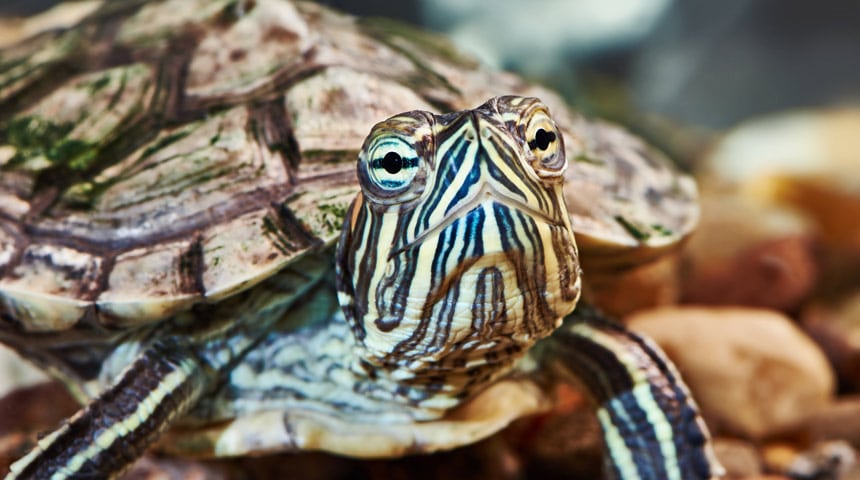
It is difficult to provide a well-balanced diet for pet aquatic and semi-aquatic turtles. Although there are species-specific dietary needs that need to be respected, there are general guidelines that can be applied to all omnivorous species. Most pet aquatic and semi-aquatic turtles are omnivorous, and their diet should ideally be composed of fresh vegetal products and fresh animal protein sources. The proportion and type of protein sources will vary according to the species of turtle.
Since most commercial turtle feeds have not been proven to be reliable long-term diets (lack of product information and labelling, inappropriate nutrient content and proportions, lack of scientific studies), some owners prefer to prepare their own turtle food. With an attention to detail, it is possible to provide a fresh and balanced diet to turtles and to prevent common malnutrition problems.
A complete jelly recipe for aquatic turtles
The following recipe comes from an article published in:
Chéloniens, la Revue de la Fédération Francophone pour l'Élevage et la Protection des Tortues :
Rasmont P. Un aspic simple et bon marché pour tortues aquatiques. Chéloniens 27 (2012) 12-17
| Ingredients | Quantity | Alternatives | Not recommended |
| Gelatin 200° Bloom | 80 g | Gelatin sheets (more expensive, difficult to make rise) | Agar-agar |
| Fish: Trout | 200 g | Sole, Haddock, Pangasius | See attached list1 |
| Meat: beef heart or veal liver | 200 g | Pork heart/liver, white poultry, poultry liver. Liver disintegrates well in water | Fatty meats (i.e.: ground beef) |
| Green beans | 400 g | Curly or romaine lettuce, escarole | Cabbage family seems to be less appreciated |
| Grated carrots | 300 g | Exotic fruits: kiwi, pineapple, mango, papaya...2 | |
| Cooked shrimp | 150 g | Other shell fish | Mussels3 |
| Vitamins | 30 g | Beware of overdosing | |
| Calcium lactate, gluconate or carbonate | 30 g | Fresh cuttlebone from the fish monger | Calcium sulfate or phosphate, bone meal |
| Effervescent vitamin C4 | 500mg | ||
| Cochineal red dye (E 124)5 | A pinch | Beware of overdosing | |
| Water | 1 L |
1 Fish should be offered whole (not eviscerated) and fresh. They are rich in protein and essential amino acids, lipids, vitamins A and D (in the liver), vitamins K and B12 (in the intestines), and in minerals, and are poor in carbohydrates.
Smelt and mackerel: high fat content and too rich in polyunsaturated fats, which may induce a vitamin E (tocopherol) deficiency and steatitis (liver disease).
Smelt, sardine, carp, herring, sculpin, catfish, goldfish: rich in anti-vitamin B1 (thiaminases)
Sardines and anchovies: rich in purines, may provoke visceral and articular gout if offered in large proportions.
It is important to note that wild-caught fish may carry parasites that can contaminate turtles.
2 These fruit contain proteolytic enzymes that prevent the gelatin from solidifying.
3 Mussels are also rich in thiaminases.
4 Vitamin C supplementation is not necessary in turtles. However, as a powerful antioxidant, vitamin C will slow down the degradation of the jelly preparation.
5 Turtles are generally attracted to bright colours; red and yellow in particular.
Start by mixing 1L of cold water with the gelatin. Let stand for at least 30 minutes, or until the gelatin has absorbed all water. Prepare the fish by removing the fins and head but conserve the internal organs. Cut into large cubes. Cut the meat into large cubes as well. Combine the meat, fish, greens and carrots in the blender. Add shrimp, vitamins, and calcium. Add the vitamin C tablet after dissolving it first in a bit of water. Place the bloated gelatin in the microwave for 5 minutes to reach 125˚C. Add a pinch of food colouring to the lukewarm gelatin and mix with the other ingredients. Place the whole mixture in a large shallow dish and refrigerate for a minimum of 4 hours. Unmold the jelly once it has solidified. Cut into appropriate sized cubes. These can be placed in sealed plastic bags and frozen. Cubes should be thawed for 12 hours in the refrigerator before being offered to the turtle.
Aquatic turtles will only eat when submerged. Uneaten food left in the aquarium will contribute to bacterial and algae growth and lower water quality. Therefore, it is advisable to train turtles to eat in a separate plastic container, in order to help preserve the water quality of the aquarium. Turtles will often defecate while they eat, and so feeding them outside their aquarium reduces the quantity of fecal matter in their environment.
In addition, invertebrates such as earthworms, mealworms, silkworms, crickets or other insects, snails, slugs or even mice (pinky or fuzzy) can be offered on a weekly basis to vary the diet. Finally, aquatic plants (algae, watercress, water hyacinth, spirogyres) should be made available to the turtles, and an occasional fruit or leafy vegetable can be given as a treat. Juveniles should be fed daily, while three to four meals a week are sufficient for adults.
Édouard Maccolini, DVM, IPSAV (Zoological Medicine)

